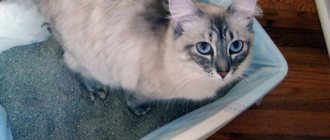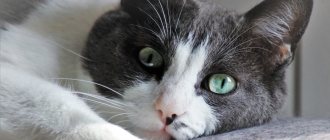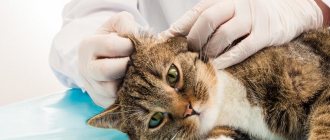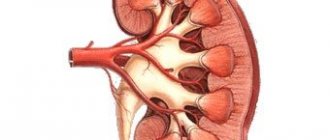Disruption of the digestive system in animals is not always a consequence of poisoning.
Diarrhea in a cat can occur due to disruption of the digestive system.
Liquid stool with mucus is an alarming symptom that the owner needs to pay attention to and take timely measures to improve the pet’s condition, otherwise irreversible consequences will develop.
Causes of discharge from the anus
Discharge in a cat during diarrhea or constipation is quite normal and quite common. They manifest themselves in different ways, but are fairly easy to identify, so they are not too dangerous. The owner may also notice a small amount of blood clots in them. This symptom disappears completely with complete recovery. Therefore, you should not worry too much about this.
But if the discharge from either the anus in a cat or the vaginal area in a cat is purulent or mucous in nature and has a characteristic odor, we can talk about the presence of an infection.
Often this can be associated with problems with the genital organs of cats. But there are other options that require careful testing, special tests and smears. Here you should seek the help of a specialist as soon as possible so as not to aggravate the situation and alleviate the cat’s suffering.
Often the cause of discharge from the anus is inflammation of the paraanal glands. Previously, many were inclined to think that such problems were directly related to the abundant use of dry food in the diet of pets. However, it turned out that this is a myth. Often, discharge appears due to the unusual structure of the intestine itself. For example, you may notice frequent attempts by the animal to sit on its hind legs or walk along the floor. Such manifestations of attempts to get rid of excess secretions should be immediately noticeable to the owner.
Discharge under the cat's tail - possible causes and dangers of pathology
Owners of domestic cats sometimes notice the appearance of discharge under the tail, which is a liquid substance. The nature of the discharge may be serous or watery, and may also contain blood or pus (yellowish or green discharge). After the end of the birth process, vaginal discharge is dark, sometimes black or greenish.
The appearance of discharge does not always indicate the development of a pathological process in the female reproductive system. Some types of discharge are physiologically determined and do not pose a threat to the life of the animal.
The presence of discharge in an animal should not be ignored, since in some cases such a symptom indicates the development of pathological changes in the area of not only the genital tract, but also the urinary system. It is recommended to contact a veterinary clinic to determine the nature of the origin of the cat’s discharge. The doctor will be able to make an accurate diagnosis and prescribe appropriate treatment.
White discharge from a cat
The appearance of white discharge from the vaginal area and loop in a cat is provoked by factors of both physiological and pathological nature. Normal discharge includes white discharge during heat and pregnancy.
During estrus, initially clear mucus is released from the cat's loop, which subsequently becomes white and has no specific odor. In addition to discharge, the period of onset of estrus in a cat is characterized by a number of symptoms - the animal arches its back, actively calls for the opposite sex, and shows anxiety.
White vaginal discharge from a cat may appear during the last stages of pregnancy. The secreted secretion is mucous and whitish in color, which is associated with the release of the plug that covers the cervix during pregnancy.
Pathological processes developing in the reproductive system of females, in the first stages, can also be characterized by the appearance of whitish discharge. The main diseases identified in veterinary medicine in cats are:
- Vaginitis - characterized by the appearance of white exudate, indicating the development of an inflammatory process. Streptococcal and staphylococcal infections can provoke the development of vaginitis in a pet.
- Endometritis is a disease localized in the area of the uterine walls. At the development stage, endometritis is characterized by the appearance of copious mucous-type discharge, which later acquires a whitish tint. They are thick and have a strong, unpleasant odor. But the following options are associated with pathological processes.
- Pyometra is a dangerous disease that often affects unsterilized females. The owner can notice changes in the cat’s behavior at home, paying attention not only to the appearance of white vaginal discharge, but also to the symptoms accompanying the development of pyometra, such as a frequent urge to urinate, a tense and swollen abdomen. The appearance of discharge during the development of purulent inflammation in the uterine cavity is characteristic of the open form of the pathology. The closed form of pyometra is not characterized by the appearance of any discharge. Quite often, pyometra develops against the background of untimely treated endometritis. The danger of the pathology lies in the fact that the animal is at risk of peritonitis, blood poisoning, which ends in death in the absence of surgical intervention.
White discharge in the loop area can be caused by uncontrolled use of contraceptive hormonal drugs. Ignorant owners purchase drugs to regulate sexual heat in cats, without thinking about the consequences for the animal’s body. In addition to endometritis and pyometra, the female may develop malignant tumors in the uterus or appendages.
In order to prevent the development of life-threatening diseases, veterinary experts recommend routine sterilization of all females that are not planned for breeding.
Purulent, bloody, or yellow discharge
Bloody, purulent or yellow vaginal discharge in a cat almost always indicates the development of inflammation. Bloody discharge in a cat during the postpartum period is considered normal and is called lochia. They can be pinkish, dark brown or almost black. The duration of lochia is from 2 to 3 weeks. Normally, discharge after childbirth should not have an unpleasant odor.
It is important to note that during the onset of the heat period, cats, unlike dogs, do not experience bleeding. Therefore, if an animal intensively licks the vulva area, and droplets of blood are visible on the bedding, it is necessary to contact a veterinary hospital for advice as soon as possible.
Yellow or white discharge is normal before labor begins. A day or several hours before birth, the owner may notice the appearance of clear, whitish or greenish discharge from the loop.
Discharge that does not go away for a long time and has an unpleasant odor is a signal of the development of pathology. You cannot do without the help of a veterinarian. When examined by a specialist, the female is not only given a clinical examination, but also prescribed a number of laboratory tests.
An obligatory point in making a diagnosis is ultrasound diagnostics.
Among the pathological causes that provoke the appearance of specific exudate from the vagina in a cat are the following:
- Pyometra is a dangerous pathology caused by purulent-necrotic inflammation in the uterine cavity. In the open form of pyometra, exudate is released, initially cream-colored, then green, yellow, bloody with impurities of pus. In some cases, conservative treatment is carried out, which is effective in the initial stages of the disease. In case of advanced pathological process, it is recommended to perform extirpation of the uterus and appendages.
- Hematometra is a disease characterized by the accumulation of a large amount of blood in the uterus against the background of hemorrhage, provoked by an advanced form of endometritis or mechanical damage. Symptoms of hematometra in a cat are bloody discharge from the loop, liquid or in the form of clots, and have an unpleasant odor. Pathogenic microflora often joins, which leads to the appearance of pus.
- Hydrometra is a pathological process that occurs against the background of other diseases, for example, endometritis that is not treated in a timely manner. It is characterized by an increased accumulation of serous exudate in the uterine cavity.
- Endometritis is a commonly diagnosed disease in unsterilized cats. Pathology occurs as a result of the development of inflammation on the inside of the uterine layer. The disease can occur in both acute and chronic forms. The discharge in the initial stages of endometritis is cloudy, yellowish, and has a repulsive odor. Endometritis does not pose a direct threat to the life of a cat, but it is fraught with the development of complications in the absence of therapy.
Before contacting a veterinary clinic, the owner should carefully examine the type of discharge, its intensity, smell and color. This will help the doctor collect a medical history to make an accurate diagnosis. A number of important studies are carried out in the clinic, including:
- general clinical blood test;
- blood biochemistry;
- bacterial culture of vaginal exudate samples to determine the sensitivity of microflora to antibiotics;
- scraping for cytological examination;
- ultrasound diagnostics of the abdominal organs.
In some cases, it is recommended to conduct serological tests for herpes and brucellosis, and study the functioning of the renal system (to determine possible concomitant pathologies).
If the discharge that appears from the vaginal area in a female is physiologically caused, therapy is not carried out. In clinical veterinary practice, there have been cases of vaginitis occurring in young cats. After going through the first heat or undergoing a sterilization procedure, vaginitis disappears on its own.
Pathological vaginal discharge requires concentration from a specialist to make a diagnosis and prescribe treatment. Depending on the type of pathology and the degree of neglect, treatment will vary.
If a cat has an infection of the reproductive system with damage to the walls of the uterus, a foreign body is found in the birth canal, or malignant tumors are diagnosed, surgical treatment is prescribed. Surgical treatment is also carried out when diagnosing congenital anomalies in the structure of the ureter and the walls that form the vaginal opening.
Purulent discharge caused by the attachment and development of pathogenic bacterial microflora is stopped with the help of antimicrobial agents. A course of antibiotic therapy is prescribed, the dosage and treatment regimen of which is determined by the veterinarian.
If disorders in the blood clotting system are diagnosed, corrective treatment is carried out. In some cases, when the cause of a cat’s discharge from the loop is a tumor, not only surgery is performed, but chemotherapy is also prescribed.
Treatment of anal discharge
But many pet owners do not want to resort to the services of veterinary clinics. Of course, if the owner is absolutely confident in his abilities and is fully aware of the situation that is happening to his cat, more independent treatment is allowed. However, beginners should listen to the opinion of doctors so as not to put their cat at risk.
Sometimes ridding a cat of anal discharge is not so easy. If the abundance of secretion does not decrease and lasts for several days, an examination should be performed. Here you must thoroughly wash and disinfect your hands. Next, you need to squeeze the area adjacent to the animal’s sphincter with two fingers. If at the same time a thick and viscous secretion occurs, it makes sense to think about the presence of certain disorders in the animal’s body.
To avoid worsening the situation, a whole range of measures should be taken to help correct the cat’s condition. Initially, you should arm yourself with special medical gloves. After smearing your finger with Vaseline, you need to insert it into the source of the cat’s discharge.
Carrying out manipulations according to the instructions will lead to an improvement in the pet’s condition within 2-3 days.
However, this procedure cannot be performed without special skills and a full understanding of what is happening. The best thing is to trust the professionals at the veterinary clinic, who will professionally take care of the animal’s health.
If the disease is advanced, doctors can prescribe complex treatment for the discharge. Both procedures and medications will be used here. Antibiotics are especially often recommended. If your cat is bleeding from the anus, this may be a reason for surgery. However, this is an extreme measure that is carried out quite rarely. Often less radical methods of treatment are sufficient, even if it involves bleeding.
After the cat’s condition improves, you should consult a doctor about preventing discharge. This will avoid relapses and improve the cat’s overall condition. Only compliance with the doctor's instructions can prevent the worsening of chronic diseases and the recurrence of inflammatory processes. He can give advice related to:
- cat care;
- food;
- routine examinations of the animal.
It's a shame when your beloved pet gets sick. Especially when the kitten has discharge from his butt. However, the main goal, in this case, should be a directed and productive fight against the disease.
Timely measures can not only alleviate the cat’s condition, but also quickly save it from a dangerous disease.
Therefore, most owners try to make every effort to create favorable conditions for their beloved animal to recover.
Treatment of kittens
When observing the first signs of diarrhea in a pet, limit its diet for 10-12 hours Instead, the animal should be given a lot of water, this will make it easier for him to endure hunger. Kittens can be kept on a fasting diet for no more than 10-12 hours, adult animals can withstand 1-2 days.
After a hunger strike, dietary nutrition is necessary. Dry food, as well as fried or fatty foods are prohibited. It is advisable to feed the kitten boiled porridge (preferably rice), boiled lean meat (chicken, beef).
If a kitten is poisoned, you can use regular activated carbon as first aid. 2 tablets must be dissolved in water and washed down with water. Another 2 tablets should be fed six hours later.
Treatment of diarrhea should include several methods at once:
- Use of hyperimmune serum for viral infections.
- Various antibiotics for bacterial infection (as indicated by high fever).
- Prebiotics are necessary to restore intestinal microflora.
- Antiparasitic drugs are used for worms.
- Papaverine is used to relieve intestinal spasms.
- Atoxil is good at removing toxins from the body.
- Regidrona restores water balance.
Why does my cat leak fluid from her anus?
The main reason that provokes discharge from the anus in a cat is inflammation of the paraanal glands.
It has been noted that long-haired pets are more susceptible to this disease than their short-haired relatives. The inflamed area on the butt gradually increases in size, and pathological exudate accumulates inside the gland. If therapy is not started in a timely manner, a bacterial infection occurs, which threatens suppuration and the development of sepsis.
Causes of diarrhea
Provoking factors include:
- rapid growth and development;
- imperfection of the digestive tract;
- weak immunity.
But the reasons that really cause diarrhea can be:
Infectious diseases
Babies are easily susceptible to infection by various bacteria and viruses, including toxoplasmosis, calcivirosis, and coronavirus enteritis.
It is impossible to determine from the appearance of stool which disease is causing diarrhea. Therefore, the breeder needs to urgently contact a veterinarian to prescribe the correct effective treatment.
Infections
Poor nutrition
Despite all the care of the owners and adherence to the diet, improper nutrition leads to disruption of the gastrointestinal tract.
Most often, the cause is overeating, since most breeders constantly offer the pet various treats, which he eats with great pleasure. In this case, the color of the stool acquires a yellowish tint.
Also, diarrhea is caused by feeding your pet food from your table (smoked meats, meat scraps) or a radical change in the food to which he is accustomed.
Invasive diseases
They occur quite often. Parasites enter the baby’s body through food, fleas, and soil, parasitizing there unnoticed until their number becomes enormous. Then the animal begins to develop indigestion, which leads to loose stools.
For example, tapeworm and coccidia cause inflammation of the large intestine, which is accompanied by diarrhea.
Stress
Cats are sensitive to emotional experiences. Even such seemingly harmless things as changing toilet litter, climate, place of residence, having a new pet and other changes. Due to strong feelings, an inflammatory process in the intestines may develop, resulting in loose stools.
Other causes include an allergic reaction, hair getting into the stomach, poisoning and the presence of serious diseases (liver and kidney diseases).
Types and symptoms
The nature of the discharge differs depending on the type of disease and the stage of its development. At the initial stage, due to inflammation localized in the anal area, the natural outflow of secretions from the glands is disrupted. When a bacterial infection occurs, yellow or white discharge that the cat leaves on the floor, carpet, and furniture is disturbing. At the time of defecation, the animal’s anus hurts, so the cat tries to visit the litter box less often, constantly screams, and worries. Other signs of the initial stage:
- extensive loss of fur;
- formation of ulcers and rashes under the tail;
- increased body temperature;
- fever.
The longer the disease progresses, the richer the color of the discharge becomes. Blood from the cat's anus indicates that the disease is advanced, and the animal needs urgent medical attention. Otherwise, the risk of developing an abscess increases, which poses a serious threat not only to the health, but also to the life of your four-legged friend.
What does blood look like in my cat's stool?
Blood in a cat's stool can be difficult to detect. For starters, cat litter can sometimes change color and hide or create changes in the appearance of the stool. If the blood originates in the lower intestine, especially the distal colon or rectal area, it will most likely appear as blood. Red or pink drops or smears are often found on the sides of the cat's litter box and on the top of the stool or litter.
Blood from the upper intestinal tract, especially the small intestine, will be black or brown. This color change is due to partial digestion by enzymes secreted in the small intestine. This blood often appears as dark spots, streaks, or looks like coffee grounds.
It's important to note that both constipation and diarrhea can cause blood in a cat's stool. Bright red blood without diarrhea or hard, dry stool usually indicates the problem is closer to the rectum and anus.
Diagnostics
If a cat has light, cloudy or bloody discharge from the anus, the anus itself is swollen and hurts when pressed, it is necessary to urgently take the animal to a veterinary clinic. An experienced veterinarian will be able to establish an accurate diagnosis during the initial examination. However, with other diseases, you may notice that ichor or blood is dripping from the anus. Therefore, additional diagnostic methods are necessarily prescribed:
- general blood and urine analysis;
- biochemistry;
- microscopic examination of feces;
- radiography;
- Ultrasound of organs located in the abdominal cavity.
Return to contents
Anal gland infection in cats
As we said earlier, damage is not the only reason why a cat's anal glands may not be working properly. Also known as sacculitis , anal gland infection in cats causes painful inflammation in one or both of the cat's anal glands. You should suspect an anal gland infection if your cat has clear or yellowish fluid, pus-like fluid, or even blood from the area. A veterinarian will be able to diagnose the problem and will likely prescribe antibiotics to treat...
What treatment is prescribed?
If a cat has a red bottom and is bleeding due to inflammation of the paraanal glands, complex treatment is necessary, which consists of the following procedures:
Taking a vitamin complex will strengthen the weakened body of the fluffy.
During therapy, the animal's immunity can be severely damaged. In order to normalize the body’s protective functions and quickly recover from an illness, vitamin and mineral complexes are prescribed. If a relapse is observed and the cat is leaking from the rear hole again, repeated cleaning is carried out urgently. Often complications and relapses of the disease occur in sterilized or neutered cats.
Treatment
Once the cause of the disease is established, treatment is selected.
Prescription of drugs
If the pet’s diet does not meet established standards, medications are used to improve digestion and relieve inflammation. These can be probiotics (Pro Plan, Lactobifid, Lactoferon).
Veterinary medicines for gastrointestinal diseases are also needed - Armavir ASD antiseptic, Veracol. To normalize nutrition, dietary industrial food is chosen.
For complications
If diarrhea is complicated by a viral or infectious disease, antibiotics are used. Then symptomatic treatment is carried out. In severe cases, the animal is left in the hospital.
Strengthening the immune system
Premium food contains all the nutrients necessary to maintain a healthy cat. Your doctor may additionally prescribe vitamin supplements.
Preventive measures
To ensure that the disease no longer bothers your pet, it is necessary to identify the original source of the problem and try to eliminate it. Often inflammation of the paraanal glands occurs due to improperly selected cat nutrition. In such a situation, it is better to contact a veterinarian who will help you create a balanced diet rich in essential vitamins, nutrients and other vital elements.
In addition, it is important to monitor the body weight of your four-legged friend and encourage him to spend time actively. You should not skip scheduled preventative visits to the doctor, during which you should describe in detail how your pet is behaving and whether it has any suspicious discharge. If relapses occur frequently in cats, to prevent complications, the veterinarian will advise removing the paraanal glands, which will save the pet from suffering.
What can be prescribed for a kitten:
- the first day is a fasting day (only water or a very weak chamomile decoction);
- for viral diseases - antiviral serum;
- for bacterial infections - antibiotic therapy;
- if the kitten is poisoned - the drug Atoxil;
- in the presence of worms - antihelminthic drugs;
- probiotics to normalize intestinal microflora;
- antispasmodics for severe pain syndromes;
- to restore the water-salt balance - Regidron.
After the therapy, the babies quickly recover, their digestive system returns to normal and the mucus in the stool disappears. Of course, provided that the owner sounded the alarm in time and consulted a doctor.
Feces with mucus in a cat are almost always a signal of the onset of an illness. Such phenomena cannot be ignored, as this can lead to serious health problems for the pet. And the blame for all the suffering of the pet will lie only with the careless owner, who did not notice the alarming symptoms in time or ignored them.
What does white discharge mean?
The appearance of white discharge from the anus and organs of vision is always alarming, since in most cases the color change is associated with the presence of pus and inflammation. If mucus was found on the loop, this may be normal.
The following signs may not indicate the presence of the disease:
- Transparent or slightly whitish mucus near the loop. May be released during estrus. Color and consistency change due to hormonal changes and the functioning of the reproductive organs. There is no unpleasant odor, the secretion may be thick.
- Discharge from the uterus after childbirth. Present for several days. They can range in color from black to greenish. Sometimes residual traces are present for 2-3 weeks. It is important not to confuse normal discharge in the postpartum period with pathological ones. If the placenta has not been delivered, the cat will constantly have watery mucus, sometimes mixed with blood.
- Whitish discharge from the loop of a pregnant cat is odorless and impurities of pus. Most often they appear 2-3 weeks before birth. Often this type of discharge is confused with pathological, so it is recommended to have the animal checked by a veterinarian.
- Transparent discharge from the eyes in a small amount. They may appear after sleep or upon contact with an irritant, such as dust. They have a liquid consistency.
In rare cases, the appearance of a small amount of mucus in the stool is considered normal. This can happen if there is insufficient water intake while feeding dry food. In such cases, mucus is secreted to protect the mucous membranes of the gastrointestinal tract from injury from coarse feces.
However, you need to pay attention if this happens often: constant irritation of internal tissues can provoke the development of diseases.
The presence of white discharge may indicate the following pathologies and abnormalities:
- Infectious diseases of the genitourinary system. White or yellow discharge from the urethra may be associated with infection with chlamydia, toxoplasmosis, mycoplasmosis, etc. The mucus in most cases has an unpleasant odor. Sometimes there are no symptoms. Infection most often occurs during mating, so you should carefully select a partner for your cat.
- Pyometra. It is characterized by the presence of an inflammatory process with abundant formation of pus. There are several types of pyometra. If a cat's white discharge gradually comes out of the loop, this is an open form. It is easier to diagnose and treat. In the closed form, the discharge does not leave the uterus, which leads to its rupture and the further development of sepsis. Such pyometra is not always detected on time, since many owners mistake an enlarged abdomen and symptoms of intoxication for pregnancy.
- Oncology. Tumors occur more often in older cats. They cause white discharge from the urethra or anus. If the tumor is located in the intestinal lumen, its individual fragments may be present in the stool. In the early stages, cancer is asymptomatic, but later common symptoms appear: refusal to eat, anxiety, weight loss, etc.
- Development of complications after surgery. In such cases, the appearance of white discharge is associated with tissue infection. Most often, repeated surgery is required to eliminate the consequences. If you do not help the animal, the infection will develop rapidly.
- Vaginitis. Characterized by inflammation of the mucous membranes of the vagina. In most cases, the disease is asymptomatic, but some cats experience copious clear or whitish discharge. The animal experiences discomfort and often licks itself, trying to alleviate the condition.
- Phlegmon. Inflammation occurs, accompanied by the formation of abscesses. Mucus mixed with pus comes out of the urethra. The animal experiences pain and the temperature rises due to inflammation.
- Pathologies of the organs of vision. Most often, the appearance of whitish mucus from the eyes is caused by infections. They can develop independently or as a result of injury. The discharge is accompanied by redness of the protein, inflammation of nearby tissues, itching, the appearance of crusts, etc.
- Cystitis. Cystitis. Often has an infectious nature of origin. First, the animal experiences problems with urination. When the mucous membranes are damaged, blood first appears in the urine, and later pus, which is excreted only in the urine.
- Kidney diseases. These include pyelonephritis, glomerulonephritis, urolithiasis, etc. If internal tissues are damaged due to inflammation, microbial activity, or injury from stones, pus and blood appear in the urine.
- Gastrointestinal pathologies. In diseases of the stomach, intestines, pancreas and liver, discharge is found in the stool. In the initial stages it is clear mucus, later it becomes white and blood is added. In advanced cases, neighboring organs may become inflamed, and then discharge from the loop may appear.
- Inflammation of the anal glands. Accompanied by the appearance of purulent discharge from the anus and in the feces. The animal licks the anal area and can move its butt on the floor. Due to the discharge, the fur near the tail becomes wet. In advanced cases, fistulas form, from which pus comes out.
- Parasites. Most often, discharge appears in the stool. This happens due to worms. In feces you can sometimes find not only mucus, but also worms or their fragments. If the infection is severe, the cat begins to vomit, the hair falls out and becomes dull.
Why did mucus appear in my cat's stool?
Mucus in the feces may be present when infected with helminths, in the presence of isospores, trichomoniasis, giardiasis.
Mucus in the stool may be present due to helminth infection.
It often happens that taking anthelmintic drugs does not stop the release of mucus in the feces. In such cases, you should not worry too much, since the dead worms continue to be excreted along with mucous feces, and after a while the stool returns to normal.
It is possible to eliminate helminthiasis at home, but the presence of inflammation and infectious pathologies requires a medical examination and full control of treatment. In this case, a full range of diagnostics should be carried out and, if a contagious disease is detected, isolation must be carried out.
Causes of the symptom
It can be said that there is rarely any disease that does not cause diarrhea. Possible reasons for the appearance of mucus in stool:
- intoxication due to poisoning;
- overfeeding;
- individual intolerance;
- violation of feeding regime;
- helminths;
- infection of viral and bacterial nature;
- inflammation of the digestive system;
- failure of exchange processes;
- fatty food;
- intestinal obstruction;
- stress;
- a change of scenery;
- menu change;
- reaction to medications;
- decreased body resistance;
- allergy;
- presence of fur in the stomach.
Mucus may appear due to eating fatty foods.
A pet can be poisoned by spoiled food, poisonous plants or chemicals from household cleaning products.
Lactose intolerance
A common occurrence in animals is lactose intolerance.
Due to the consumption of dairy products, a reaction to an intolerant product occurs.
A cat may have a reaction in the form of mucus when drinking milk.
Disturbance of balance
An imbalance when preparing a diet for a cat leads to a similar symptom.
An overdose of vitamins provokes intestinal upset.
An overdose of certain vitamins or minerals provokes intestinal upset and, as a result, diarrhea with mucus.
Inflammation of the digestive system
If there is inflammation of the digestive system or genitourinary system, diarrhea will almost always be mixed with mucus and blood.
In the presence of digestive inflammation, diarrhea will always be mixed with mucus.
For all of the above reasons, it is possible to roughly diagnose the factor of occurrence based on some characteristic signs.
- If intestinal flatulence , individual intolerance can be assumed. All that remains is to identify the specific product that causes such a symptom.
- Liquid stool with a tarry consistency and color will indicate the occurrence of helminthic infestation . It will be accompanied by vomiting and sudden weight loss.
Diagnosis of your pet's condition
Since the range of possible causes of illness is wide, treatment begins with tests and examination of the problem organ. In most cases, these are the eyes, intestines or reproductive system (depending on the location of the discharge). If the problem affects the eye organs, an examination is performed.
Pathological fluid can be taken for analysis, but most often appointments are made before the results are received.
To clarify the degree of inflammation and localization of the disease, general and biochemical blood tests are always performed. If impurities are found in the urine, an additional urine sample is taken. The indicators help identify urolithiasis, confirm or refute the presence of infection, and indicate the location of the damage.
If there is mucus in the feces, a stool test is performed. The laboratory technician can find hidden blood, which indicates a violation of the integrity of the mucous membranes, eggs of worms, protozoa, etc.
For diseases of the gastrointestinal tract and genitourinary system, an ultrasound is performed. If discharge is found in urine, the first step is to examine the bladder and kidneys. If mucus comes from the loop, the reproductive system is examined. In case of problems with the gastrointestinal tract, sigmoidoscopy can additionally be performed, but such traumatic procedures are rarely resorted to.
Basic tests as a diagnostic method
In order to diagnose the disease, the veterinarian may be interested in:
- The cat's attempts to rub its butt on the carpets. This behavior indicates an existing problem with the anal sinuses.
- Injuries, blows, bites in this area. May cause great discomfort for the animal.
- Detailed description of your pet's diet.
- Swallowed objects, ingestion of spoiled food.
If the doctor needs to clarify something, the animal may be sent for an x-ray.
Upon receipt of all the answers of interest, the veterinarian immediately makes a diagnosis or prescribes additional procedures. So, he can send the cat for feces, urine, blood, and examination of the rectum by swallowing a probe under anesthesia. By analyzing the profile of chemical elements in the bloodstream, it is possible to understand what is happening in the body. Colonoscopy and x-rays of organs are performed as prescribed by the doctor. As a result of receiving answers, effective and efficient treatment of the disease is selected.
What to do if there is blood in the discharge
The appearance of blood in the discharge indicates a violation of the integrity of the mucous membranes. The next stages most often are infection, formation of pus and filling of the problem organ with it. In the absence of help, tissue ruptures and sepsis develops. There is a high probability of death, so with this symptom you need to take the animal to the veterinarian as quickly as possible.
It is not recommended to do anything on your own: blood can appear for several reasons. Due to self-medication, at best you will waste time, at worst you will aggravate the animal’s condition.
How to treat blood in stool
We told you what to do before going to see a doctor, now let’s talk about how the treatment will proceed. Treatment for this pathology may include the following:
- injections of antibiotics to reduce inflammation in the cat's intestines;
- prescription of antibacterial, anti-inflammatory, antihistamine and other drugs;
- surgery to remove polyps and cancerous tumors;
- use of anthelmintic drugs for helminthic infestation;
- elimination of the inflammatory process in the paraanal glands: drainage, treatment with medicinal solutions;
- transferring the animal to a special therapeutic diet;
- prescribing laxatives to loosen stools and facilitate bowel movements;
- installing IVs if there is a risk of dehydration;
- inserting suppositories with medicines and sea buckthorn oil into the cat’s anus;
- installation of an enema for emptying and cleansing the intestines of feces.
A treatment regimen, medications and a therapeutic diet should be prescribed by a doctor after making a final diagnosis.
Self-medication in this case is unacceptable
! It can lead to serious deterioration of the pet's condition and death.
Possible treatments
Veterinarians can choose conservative or surgical treatment. The first involves the use of medications. Since in most cases the symptom appears due to infection, antibiotics are most often prescribed. The drug is selected depending on the strains of pathogens, since their sensitivity differs. Pending test results, a broad-spectrum agent may be prescribed.
If severe inflammation is detected in the animal, accompanied by copious formation of pus, surgery may be performed. Surgical intervention is performed for pyometra, removing the uterus. This helps prevent tissue necrosis, organ rupture, and peritonitis.
First aid
As soon as the cat has loose stools and the number of bowel movements per day exceeds 3, the animal needs to be given first aid.
Therapeutic fasting
First of all, access to food is limited.
After the onset of diarrhea, it is useful for the animal to fast - this reduces the load on the digestive tract and accelerates the removal of toxins from the body.
Tray Access
The cat's litter box should remain clean, regardless of the number of bowel movements per day. A box with filling is placed near the animal.
Fixing decoctions
On the first day, it is useful to give the cat a restorative decoction. It can be chamomile (acts as an antiseptic), St. John's wort (relieves inflammation), oak bark (fixes).
1 tbsp. l. any herb is poured with a glass of boiling water, the liquid is simmered in a water bath for 15 minutes. Afterwards, wrap the container, let it brew and cool. The finished broth is poured into the pet’s oral cavity, 1 tbsp. l. three times a day.
Contacting a veterinarian
If the diarrhea does not stop, or the animal gets worse, then you need to call a veterinarian at home . A specialist will examine the pet and find out the cause of this condition. Treatment is prescribed only after diagnosis.
Pharmacy products
To treat diarrhea in cats, it is recommended to use drugs created for humans.
In case of poisoning, Enterofuril can be used. This is a broad-spectrum antimicrobial drug. It is prescribed for bacterial and viral infections.
Bifidumbacterin helps restore intestinal microflora. The probiotic is effective for intestinal disorders of any etiology.
Activated carbon is a sorbent that removes toxins from the body. It is used for short-term and uncomplicated diarrhea. In this case, Smecta also helps.
Prevention of diarrhea
Prevention is based on diet. The food must be constantly fresh and of good quality. You should not suddenly switch your baby to a new diet; do it gradually. Also don't forget about vaccinations.
To summarize, we can say that a kitten can develop diarrhea for numerous reasons, but most often due to poor nutrition. Therefore, proper care and adherence to the diet are the most important preventive measures aimed at a full life and development of the pet.











